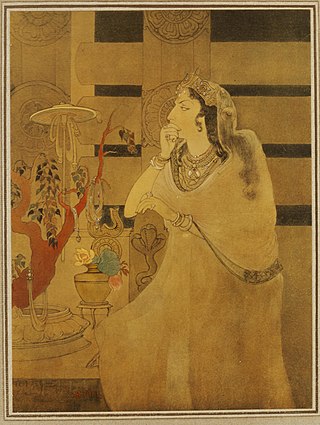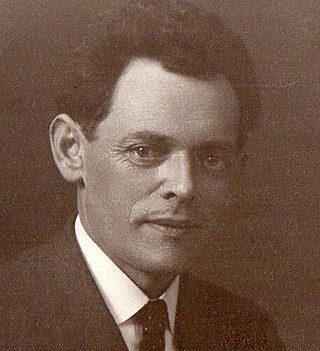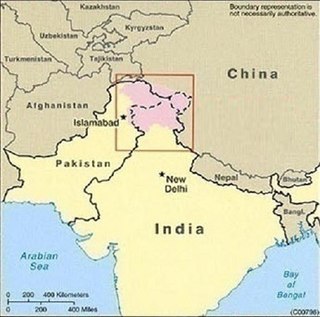
Ashoka, popularly known as Ashoka the Great, was the third Mauryan Emperor of Magadha in the Indian subcontinent during c. 268 to 232 BCE. His empire covered the largest part of the Indian subcontinent, stretching from present-day Afghanistan in the west to present-day Bangladesh in the east, with its capital at Pataliputra. A patron of Buddhism, he is credited with playing an important role in the spread of Buddhism across ancient Asia.

Chandragupta Maurya was the founder of the Maurya Empire, a geographically-extensive empire based in Magadha. He reigned from 320 BCE to 298 BCE. The Magadha kingdom expanded to become an empire that reached its peak under the reign of his grandson, Ashoka the Great, from 268 BCE to 231 BCE. The nature of the political formation that existed in Chandragupta's time is not certain. The Mauryan empire was a loose-knit one with large autonomous regions within its limits.

Chanakya was an ancient Indian polymath who was active as a teacher, author, strategist, philosopher, economist, jurist, and politician. He is traditionally identified as Kauṭilya or Viṣṇugupta, who authored the ancient Indian political treatise, the Arthashastra, a text dated to roughly between the fourth century BCE and the third century CE. As such, he is considered the pioneer of the field of political science and economics in India, and his work is thought of as an important precursor to classical economics. His works were lost near the end of the Gupta Empire in the sixth century CE and not rediscovered until the early 20th century. Around 321 BCE, Chanakya assisted the first Mauryan emperor Chandragupta in his rise to power and is widely credited for having played an important role in the establishment of the Maurya Empire. Chanakya served as the chief advisor to both emperors Chandragupta and his son Bindusara.
Gandhara was an ancient Indo-Aryan civilization centred in present-day north-west Pakistan and north-east Afghanistan. The core of the region of Gandhara was the Peshawar and Swat valleys extending as far east as the Pothohar Plateau in Punjab, though the cultural influence of Greater Gandhara extended westwards into the Kabul valley in Afghanistan, and northwards up to the Karakoram range. The region was a central location for the spread of Buddhism to Central Asia and East Asia with many Chinese Buddhist pilgrims visiting the region.

Bindusara was the second Mauryan emperor of Magadha in Ancient India. The ancient Greco-Roman writers called him Amitrochates, a name likely derived from his Sanskrit title Amitraghāta.

The Maurya Empire was a geographically extensive Iron Age historical power in South Asia based in Magadha. Founded by Chandragupta Maurya in 322 BCE, it existed in loose-knit fashion until 185 BCE. The empire was centralized by the conquest of the Indo-Gangetic Plain; its capital city was located at Pataliputra. Outside this imperial centre, the empire's geographical extent was dependent on the loyalty of military commanders who controlled the armed cities scattered within it. During Ashoka's rule, the empire briefly controlled the major urban hubs and arteries of the Indian subcontinent excepting the deep south. It declined for about 50 years after Ashoka's rule, and dissolved in 185 BCE with the assassination of Brihadratha by Pushyamitra Shunga and foundation of the Shunga dynasty in Magadha.

Mahinda was an Indian Buddhist monk depicted in Buddhist sources as bringing Buddhism to Sri Lanka. He was a Mauryan prince and the first-born son of Emperor Ashoka The Great from his first wife and Empress Devi, and the older brother of Princess Sanghamitra.

Saṅghamittā was an Indian Buddhist nun and believed to be the eldest daughter of Emperor Ashoka and his first wife and Empress, Devi. Together with her brother Mahinda, she entered an order of Buddhist monks. The two siblings later went to Sri Lanka to spread the teachings of Buddha at the request of King Devanampiya Tissa who was a contemporary of Ashoka. Ashoka was initially reluctant to send his daughter on an overseas mission. However, because of the insistence of Sangamitra herself, he finally agreed. She was sent to Sri Lanka together with several other nuns to start the nun-lineage of Bhikkhunis at the request of King Tissa to ordain queen Anulā and other women of Tissa's court at Anuradhapura who desired to be ordained as nuns after Mahindra converted them to Buddhism.
Kunala was the Crown Prince and second son of 3rd Mauryan Emperor Ashoka and Empress Padmavati and the presumptive heir to Ashoka, thus the heir to the Mauryan Empire which once ruled almost all of the Indian subcontinent. After the departure of Mahendra, Ashoka's eldest son, he was supposed to be the heir to the empire, but was blinded by his step-mother, Tishyaraksha, at a young age in jealousy. While he was not able to take the throne, his son, Samprati, became his heir.

Tissa, later Devanampiya Tissa, meaning, was one of the earliest kings of Sri Lanka based at the ancient capital of Anuradhapura. According to the traditional chronology, he ruled from 307 BC to 267 BC, but the modified chronology adopted by modern scholars such as Wilhelm Geiger assigns his reign to 247 BC to 207 BC. His reign was notable for the arrival of Buddhism in Sri Lanka under the aegis of the Mauryan Emperor Ashoka the Great. The primary source for his reign is the Mahavamsa, which in turn is based on the more ancient Dipavamsa.

Tishyaraksha or Tissarakkhā was the fifth and last wife of the third Mauryan emperor, Ashoka. According to the Ashokavadana, she was responsible for blinding Ashoka's son and heir presumptive Kunala. She was very jealous of the attention paid by Ashoka to the Bodhi-tree, and caused it to be killed by means of poisonous thorns.
Susima Maurya was the crown prince of the Maurya Empire of ancient India and the eldest son and heir-apparent of the second Mauryan emperor Bindusara. He was next in line for his father's throne, but was killed in a succession conflict by his younger half-brother, Ashoka, who eventually succeeded Bindusara as the third Mauryan emperor.

Moggaliputtatissa, was a Buddhist monk and scholar who was born in Pataliputra, Magadha and lived in the 3rd century BCE. He is associated with the Third Buddhist council, the Mauryan emperor Ashoka and the Buddhist missionary activities which took place during his reign.

The Ashokan edicts in Delhi are a series of edicts on the teachings of Buddha created by Ashoka, the Mauryan Emperor who ruled in the Indian subcontinent during the 3rd century BC. The Edicts of Ashoka were either carved on in-situ rocks or engraved on pillars erected throughout the empire; examples of both are found in Delhi.

The Anuradhapura period was a period in the history of Sri Lanka of the Anuradhapura Kingdom from 377 BCE to 1017 CE. The period begins when Pandukabhaya, King of Upatissa Nuwara moved the administration to Anuradhapura, becoming the kingdom's first monarch. Anuradhapura is heralded as an ancient cosmopolitan citadel with diverse populations.

Chandragupta is a board wargame designed by Stephen R. Welch and released in 2008 by GMT Games as part of the Great Battles of History (GBoH) series of games on ancient warfare. Chandragupta simulates battles fought by the Mauryan Dynasty in ancient India, and in so doing, attempts to illuminate the features, challenges, and unique attributes of the Indian military system and culture during this period.

Wytze or Wietse Keuning was a Dutch school teacher, author and classical music critic. He was the co-author of three series of successful primary schoolbooks and one book of folk tales for young people. He wrote three novels situated in the northern part of Holland and a three-part three-volume fictionalized biography of Ashoka the Great. Keuning finished writing a two-part historical novel on Helena, the mother of Constantine the Great, but died before the publication process was started.

Chakravartin Ashoka Samrat is a 2015 Indian historical drama TV series that aired on Colors TV from 2 February 2015 to 7 October 2016. The show was created and written by author and screenwriter Ashok Banker. It stars Mohit Raina as Ashoka with Siddharth Nigam portraying the young version of the character.
The information about Mother of Ashoka The Great, the 3rd Mauryan emperor of ancient India, varies between different sources. Ashoka's own inscriptions and the main texts that provide information about his life do not name his mother. The Asokavadanamala names her Subhadrangi, while Vamsatthapakasini calls her Dharma. Different texts variously describe her as a Brahmin or a Kshatriya.

Jalauka was, according to the 12th century Kashmiri chronicle, the Rajatarangini, a king of Kashmir, who cleared the valley of oppressing Malechas. Jaluka was reputed to have been an active and vigorous king of Kashmir, who expelled certain intrusive foreigners, and conquered the plains as far as Kannauj. Jalauka was devoted to the worship of the Hindu god Shiva and the Divine Mothers, in whose honour he and his queen, Isana-devi, erected many temples in places which can be identified.Ashoka’s death his mighty empire had fragmented into as many as four or five regional kingdoms each ruled by his sons or grandsons, among them Jalauka in Kashmir, who reversed his father’s policies in favour of Shaivism and led a successful campaign against the Graeco-Bactrians, themselves seeking to take advantage of the power vacuum in north-west India to reclaim Taxila.
















